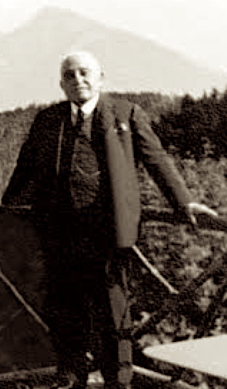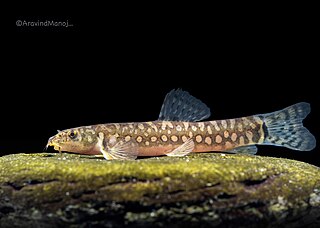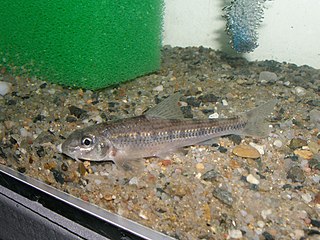
Grigore Antipa was a Romanian naturalist, zoologist, ichthyologist, ecologist, oceanologist, Darwinist biologist who studied the fauna of the Danube Delta and the Black Sea. Between 1892 and 1944 he was the director of the Bucharest Natural History Museum, which now bears his name. He is also considered to be the first person to modernize the diorama by emphasizing the three-dimensional aspect and first to use dioramas in a museum setting. He is the scientist who reorganized the Grigore Antipa National Museum of Natural History in the new building that today bears his name, designed by the architect Grigore Cerchez, built in 1906 and inaugurated by Carol I of Romania in 1908. He was elected as member of the Romanian Academy in 1910 and was also a member of several foreign academies. Grigore Antipa founded a school of hydrobiology and ichthyology in Romania.

The Kessler's gudgeon is a European species of freshwater fish in the family Cyprinidae. It is found in the Danube and Vistula drainage basins, including parts of Poland, Austria, the Czech Republic, Ukraine, Bulgaria, Romania, Moldova, Hungary, Croatia, Bosnia and Herzegovina, Serbia, Montenegro, Slovakia, and Slovenia. It is a small fish of no economic or sporting importance. It was at one time classified as Gobio kessleri.

Bathybates hornii is a species of fish in the family Cichlidae. It is endemic to Lake Tanganyika where it forms schools and feeds mainly on clupeids. This species is apparently rather rare. It is little known and it is normally recorded from deep water during the day and moves towards the shorelines at night. The identity of the person honoured in this fish's specific name is uncertain but it is likely to be either, or both, of the Horn brothers, Adolf or Albin, who explored German East Africa and collected specimens for the Vienna Museum where the describer Franz Steindachner was curator of fishes.

Werner's catfish is a species of airbreathing catfish. It is found in Burundi and Tanzania. Its natural habitats are rivers and freshwater lakes. It is threatened by habitat loss. This species reaches a length of 23.0 cm SL.
The kotso is a species of cichlid fish from northwestern Madagascar. Currently rated as data deficient by the IUCN, this species is virtually unknown. The only known specimen is a juvenile that was collected more than 80 years ago. It is not entirely clear where it was collected, but likely from the Maintimaso River or Lake Ambanja, which both are part of the Betsiboka River drainage. Erroneously, the name P. petiti has often been applied to members of a different species, P. dambabe. The specific name honours the French zoologist and anatomist Georges Petit (1892-1973) of the Muséum national d’Histoire naturelle, who collected type.
Mugilogobius sarasinorum, Sarasin's goby, is a species of goby endemic to Lake Poso in Sulawesi, Indonesia. This species can reach a length of 8 centimetres (3.1 in) TL. It is important to local commercial fisheries and the fishing community.
Teramulus waterloti is a species of silverside from the subfamily Atherinomorinae which is endemic to Madagascar. This species occurs in rivers, creeks, and streams in north western Madagascar from the Mananjeba River south to the Anjingo River. The IUCN classify this species as Endangered and it is threatened by deforestation which degrades its habitat through sedimentation and by the introduction of invasive fish species such as Channa maculata. This fish was described in 1932 as the subspecies waterloti of Atherina duodecimalis by Jacques Pellegrin who named it after Georges Waterlot (1877-1939), a collector of specimens in Africa and Madagascar for Muséum national d'histoire naturelle, including the type of this species, which he collected from Antikotazo Creek, District d'Ambilobé, Diégo Suarez Province.

Osteobrama belangeri is a species of ray-finned fish in the genus Osteobrama. It was found in the Indian state of Manipur, but has been extirpated there and as of 2022 is found in the wild only in Myanmar. Farmed populations in Manipur and wild-caught fish from in Myanmar are used as food. The extirpation from Manipur was caused by dam building, habitat degradation and the introduction of alien species which caused the populations to fragment.
Knipowitschia cameliae, the Danube delta dwarf goby, is a species of goby known only from the brackish and fresh waters of a lagoon south of the Danube Delta in Romania. This fish is a shallow water species being found in waters less than 1 metre (3.3 ft) deep. This species can reach a length of 3.2 centimetres (1.3 in) SL. This species has been assessed by the IUCN as Critically Endangered, possibly extinct, it was last recorded in 1994 and surveys in that year and 1998 have failed to record the species. The specific name honours Camelia Iliana Nalbant, the wife of the senior author.

Cyprinella whipplei, the steelcolor shiner, is a freshwater fish species found in North America. It is common throughout the Mississippi River basin and in the Black Warrior River system in Alabama.
Citharidium ansorgii is a species of lutefish found in the Niger River basin in Nigeria and also reported to be foundCameroon. It is the only member of its genus. Its conservation status is of the least concern. The only known threats which could negatively affect the population of this species are oil studies in the Lower Delta and potential impact of the invasive water hyacinth in the inland delta.
Herichthys deppii, also known as the Nautla cichlid, is a species of cichlid native to the Nautla and Misantla rivers of Mexico. It reaches a maximum size of 12 centimetres (4.7 in) TL. The specific name honours the German naturalist, explorer and painter, Ferdinand Deppe, (1794-1861) who collected the type specimen.

Mesonoemacheilus herrei is a critically endangered fish described by Teodor T. Nalbant and Banarescu in 1982. It is endemic to India and is currently only recorded within the Indira Gandhi Wildlife Sanctuary and National Park in Tamil Nadu.

The Danube whitefin gudgeon is a species of freshwater fish in the family Cyprinidae. It is distributed in the Danube drainage. The maximal length is 11.5 cm, maximal reported age 4 years.

The northern whitefin gudgeon is a species of freshwater fish in the family Cyprinidae. It is distributed in the northern Black Sea basin, southern Baltic Sea basin, southern North Sea basin. Also, reports from lakes Ilmen and Ladoga and its basins have been made, which are questionable. Their maximal length is 11.5 cm, with a maximal reported age of 5 years.
Apletodon bacescui is a species of clingfish of the family Gobiesocidae. The species is endemic to the Black Sea, where it is found in the south western part of the sea off Romania and Bulgaria, along the northern coast of Anatolia to central Turkey. This species was described by Adriana Antoniu-Murgoci in 1940 from specimens collected by zoologist Mihai C. Bacescu (1908-1999) of the Grigore Antipa National Museum of Natural History in Bucharest while he was dredging in the Black Sea.
Romanogobio johntreadwelli is a species of cyprinid fish endemic to China.
The South Caucasian gudgeon is a species of cyprinid fish found in the Kura and Aras drainages flowing to the southwest Caspian Sea from headwaters in Turkey down to lower reaches in Azerbaijan and Iran.
Romanogobio parvus is a species of cyprinid fish endemic to the Kuban River in Russia.
Squalidus wolterstorffi is a species of cyprinid fish endemic to southeastern China.










